Crematorium at Auschwitz I
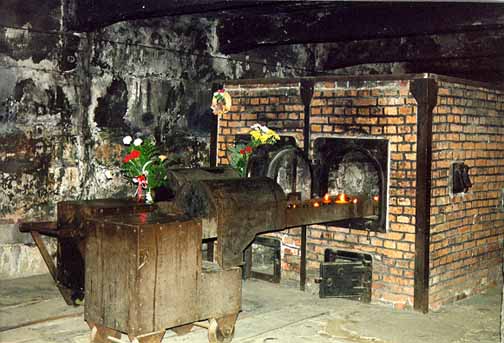
Trolley used to shove
bodies inside the ovens, 1998 photo
The crematorium in the main Auschwitz
camp, later designated as Krema I, was first put into operation
in September 1940; prior to that time, bodies were taken to Gleiwitz
to be burned in the city crematorium.
Initially, this crematorium contained
two ovens which each had two openings, called muffles or retorts.
Bodies were shoved inside by means of a device shown in the photo
above. The ovens were deep enough to hold two bodies, placed
end to end. A third oven was installed at the end of 1941. Krema
I was in operation until July 1943.
The photo above shows one of the two
ovens which were reconstructed by the Soviet Union in 1947 when
the main camp was turned into the Auschwitz Museum. The small
doors at the bottom were for removing ashes.
The blueprints for the crematorium at
Auschwitz I show that there were three ovens when the crematorium
was in operation. The picture below shows another trolley which
is in front of where the third oven used to be, behind the first
two and in front of the window on the outside wall. According
to the construction plans, the windows were added when the building
was converted into an air raid shelter.
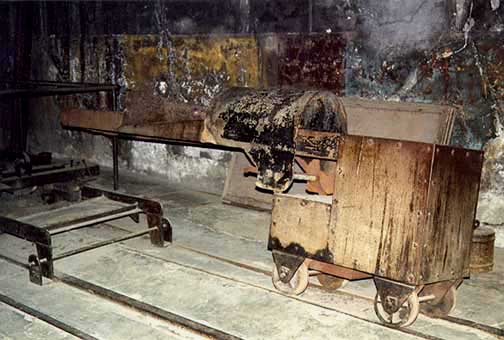 Trolley and switching
mechanism where third oven once stood, 1998 photo
Trolley and switching
mechanism where third oven once stood, 1998 photo
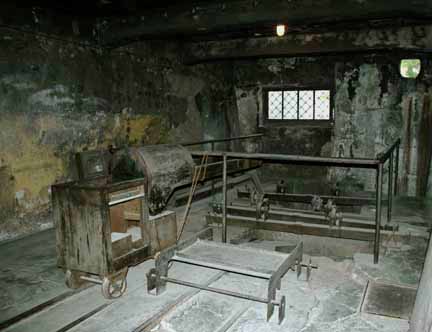 Outside window was
added during construction of air raid shelter, 2005 photo
Outside window was
added during construction of air raid shelter, 2005 photo
According to a book which I purchased
at the Auschwitz museum, the ovens in Krema I had been removed
by the Nazis before the Soviet Union liberated the camp, and
the building was being used as an air raid shelter.
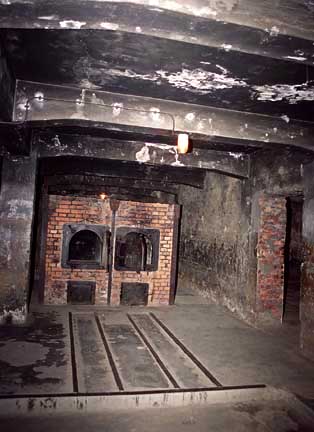
Cremation oven at Auschwitz
main camp
The 2005 photo immediately above shows
a view of the oven room, as seen from the vestibule just inside
the exterior door through which the victims entered the gas chamber
building. On the right side of the photo above, you can see the
reconstructed doorway into the gas chamber. The gas chamber room
was originally a morgue where dead bodies were stored until they
could be cremated in these ovens. The original doorway was lined
up with the track for the trolleys, which is shown in the photo
below.
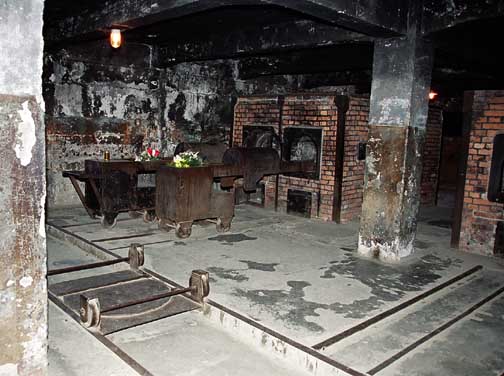 Metal frame used to
rotate trolleys 90 degrees, 2005 photo
Metal frame used to
rotate trolleys 90 degrees, 2005 photo
The 2005 photograph above shows the crematorium
ovens with large metal trolleys on wheels in front of two of
the muffles of one oven. These trolleys were used to shove the
bodies inside; they were made of cast iron with a sheet metal
part in front that was pushed inside the oven. Note the depth
of the ovens, which allowed two bodies to be burned in each muffle.
The bodies were removed from the morgue
and put on the trolleys shown in the photos above. The metal
frame on the floor in the foreground on the left, in the photo
above, is a switching facility which was used to rotate the trolley
90 degrees so that the bodies could be shoved inside the ovens.
The 1998 photograph below shows that
the crematorium was located right next to the former mortuary
room, which was converted into a gas chamber. According to Franciszek
Piper, the director of the Auschwitz Museum, the morgue was 51
feet long by 13.8 feet wide; the ceiling was 9 feet high. On
the right, you can see through the doorway into the former morgue,
now a reconstructed gas chamber room, where people from a tour
group are standing. The oven room is narrow, but wider than the
gas chamber room.
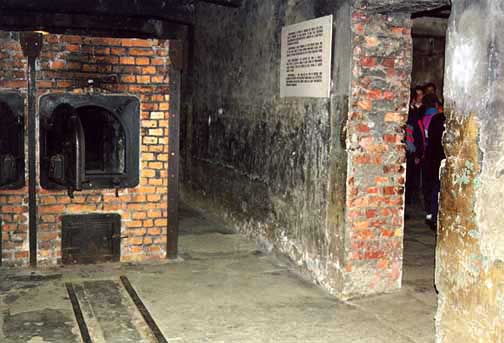
Oven in crematorium
room, gas chamber on the right, 1998 photo
The photo above shows the new doorway
which was cut when the gas chamber was reconstructed in 1947;
as you can see, there is no doorframe, nor any marks where a
doorframe was removed. The original doorway was closed up when
the gas chamber was converted into an air raid shelter. The reconstructed
doorway is about two and a half feet closer to the ovens than
the original doorway which was lined up with the trolley tracks.
The victims entered the gas chamber through
a door on the right side of the small vestibule at the entrance,
not through the oven room. However, the victims would have been
able to feel the heat of the ovens and even to see the ovens
if the door from the vestibule into the crematorium was open
as they walked into the building, believing that they were being
herded inside to take a shower.
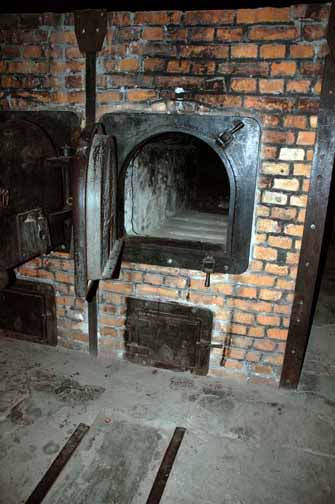 Close-up of oven in
Krema I, 2005 photo
Close-up of oven in
Krema I, 2005 photo
The photo below shows Laura Bush putting
flowers on one of the trolleys as President George W. Bush looks
on. This is a press photo taken on the occasion of their visit
to Auschwitz in May 2003.
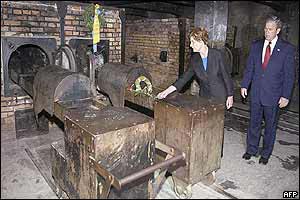 President George W.
Bush in the oven room at Auschwitz
President George W.
Bush in the oven room at Auschwitz
According to a book entitled "Auschwitz"
which I purchased at the camp, the three ovens had a capacity
of 340 bodies in a 24 hour period, less than half the capacity
of the gas chamber, which was 600 to 800 people. The gas chamber
originally had no ventilation system, so it took some time to
air out the room between gassings.
Before the air raid shelter was constructed
in 1944, the crematorium was used to store urns for ashes, according
to a book entitled "Anatomy of Auschwitz Death Camp,"
edited by Israel Gutman and Michael Berenbaum.
The photo below, taken in the Buchenwald
crematorium, shows the type of urns used by the Nazis at all
the concentration camps.
 Urns used to store
ashes in the Nazi concentration camps
Urns used to store
ashes in the Nazi concentration camps
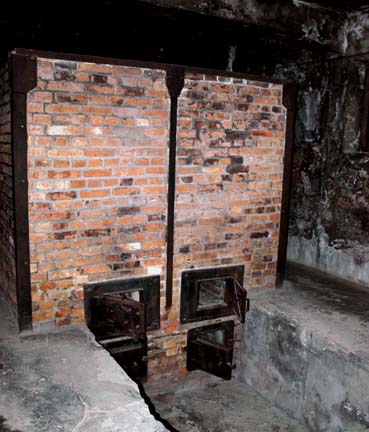 Rear view of the cremation
ovens at Auschwitz
Rear view of the cremation
ovens at Auschwitz
The photo above shows the back side of
the ovens. The top openings were used to put fuel in for burning.
The bottom openings were for removing the ashes.
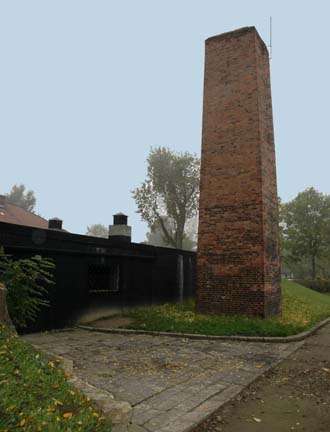 Reconstructed chimney
is not connected to the ovens
Reconstructed chimney
is not connected to the ovens
The photo above shows the brick chimney
that was reconstructed in 1947. Note that it is completely detached
from the building and it is not connected to the reconstructed
crematory ovens. The original chimney was round, according to
Filip Müller, a prisoner who worked in the crematorium,
but it had to be replaced and the new chimney was square shaped.
Other witnesses say that the original chimney was square.
This page was last updated on August
31, 2007
|